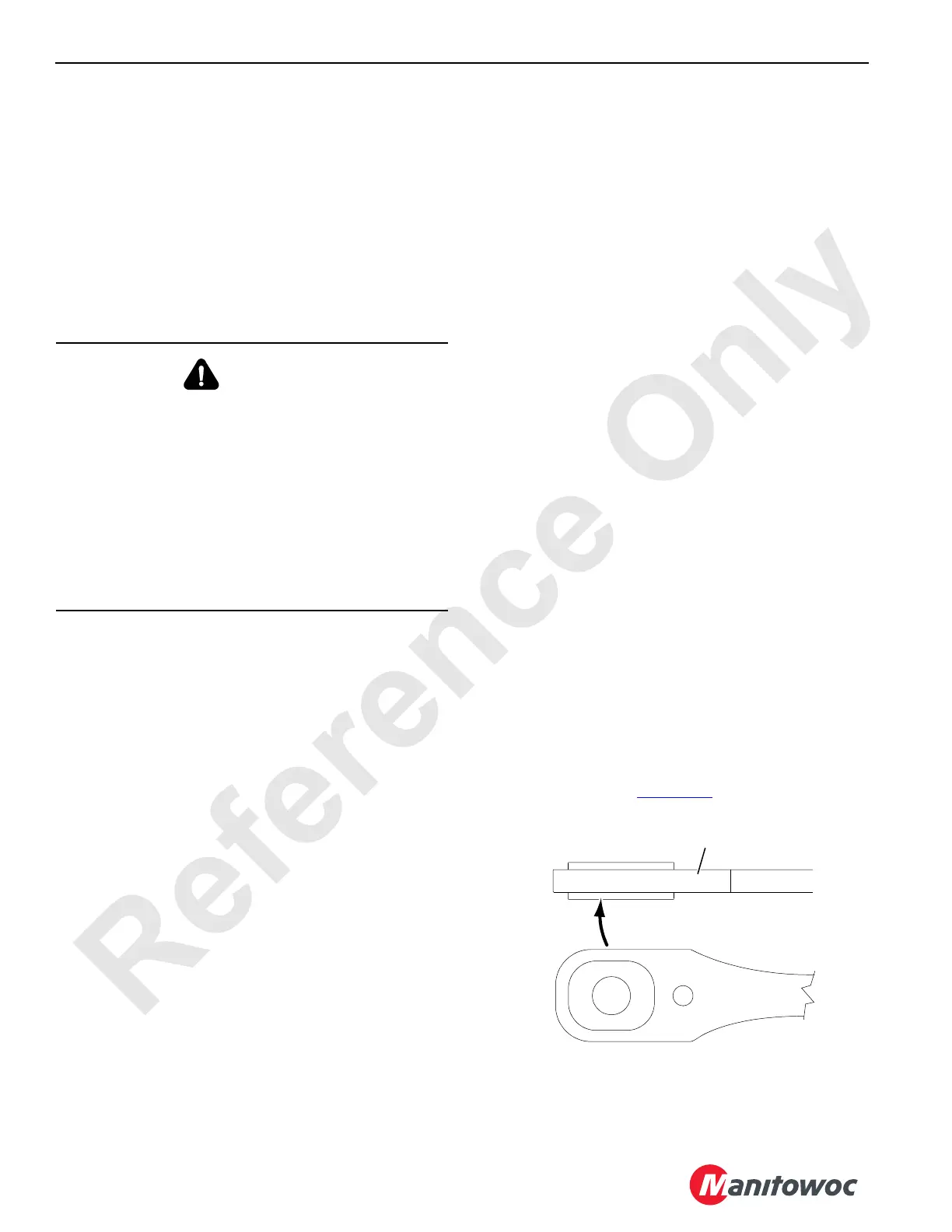BOOM 2250 SERVICE/MAINTENANCE MANUAL
4-16
Published 07-19-16, Control # 249-01
STRAP INSPECTION AND MAINTENANCE
This is a guide for properly inspecting and maintaining straps
in the field. It is impossible to predict whether or when a strap
may fail. Frequent inspections can help reveal potential for
failure. A qualified person should inspect straps regularly
and keep dated records as part of the crane’s preventive
maintenance program.
Strap repairs are prohibited. Perform only the maintenance
indicated. For inspection procedures not covered in this
service manual, contact your dealer or the Manitowoc Crane
Care Lattice Team.
Strap connecting links are subject to the same inspection
procedures and replacement specifications as those for the
straps. The word “strap” means the strap and its connecting
links.
Inspection
A routine inspection of all straps is necessary to ensure that
the crane can lift its rated load. If a strap fails, the boom or
other attachment can collapse. A qualified, appointed
inspector shall perform all inspections at the following
intervals:
• Routinely—daily (frequent inspection) or monthly
(periodic inspection)
• Before initial use
• After transport
• After an overload or shock loading has occurred
• If the boom or jib has come into contact with another
object such as power lines, a building, or another crane
• If the boom or jib has been struck by lightning
Frequent Inspection
Visually inspect all straps once each shift for obvious
damage that poses an immediate hazard. Pay particular
attention to areas where wear and other damage is likely to
occur. Look for straps that are disconnected, loose, or
sagging excessively and for distortion, such as kinking or
twisting. If a strap looks like it is damaged, it must be
checked to make sure it is within specification.
Periodic Inspection
Periodic inspection must be performed at least monthly.
During this inspection, the entire length of strap must be
inspected to ensure that it is within specifications.
NOTE: All straps must be within specification. Any damage
found must be recorded and a determination made
as to whether continued use of the strap is safe.
Before beginning an inspection, thoroughly clean the strap of
all dirt, grease, and oil so a thorough inspection can be
made. Examine areas where paint is chipped, wrinkled, or
missing and where faint rust lines or marks appear.
A qualified inspector may modify the interval for periodic
inspection depending on the following factors:
• The severity of the environment in which the crane is
operated
• The size, nature, and frequency of lifts
• Any exposure to shock loading or other abuse
Inspecting the Straps on Idle Cranes
A qualified inspector should determine the type of inspection
required for cranes that are not being used (idle). A frequent
inspection (visual observation) should be adequate for a
crane that has been idle for less than six months. A periodic
inspection is required for cranes that have been idle for more
than six months.
Identifying Straps
To aid in strap identification, a part number is stamped into
both ends of each strap (Figure 4-11
).
WARNING
Falling Attachment Hazard!
Operating the crane with a damaged strap can cause
structural failure or collapse of the boom, jib, mast, or
other crane components, which can cause death or
serious injury.
If damage to a strap was caused by an overload or a
shock load, or if there is damage to other major structural
components, Manitowoc Cranes recommends that a
thorough inspection be made by a qualified person. A
nondestructive test of all critically stressed members must
be made.
XXXXXX
Part Number
A1012
FIGURE 4-11

